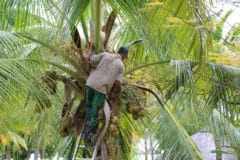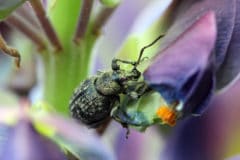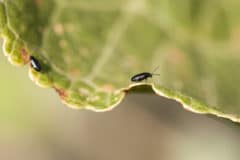Plant Types at Risk
Although the coconut rhinoceros beetle’s main plant of choice is the tropical coconut palm, other plants are also at risk of an attack:
- Various palms, including oil palms and date palms.
- Pineapples
- Bananas
- Sugarcane
- Various Agaves
Beetle Description
An adult coconut rhinoceros beetle is relatively large, ranging just over an inch to 2.5 inches long (3.0 to 6.3 cm) and are black to dark brown. The underside of both males and female beetles, have fuzzy reddish-brown hairs and a horn used to move through tightly packed leaves. The males’ horn is usually longer than the females.
Beetle’s Life-Cycle
The coconut rhinoceros beetle lays its eggs in decaying matter like logs, stumps, leaf debris or other decaying vegetation. The eggs hatch in just over a week and the larvae continues feeding and growing. It takes anywhere from three to six months before they enter the pupae stage, which lasts for two to three weeks.
Adult beetles emerge from their pupae cell, fly to the crown of a palm tree and begin feeding. The beetles are only active during the nighttime hours and remain hidden in their feeding areas during the day. An adult coconut rhinoceros beetle lives anywhere from four to nine months and during a female beetle’s lifetime she can lay 50 to 100 eggs.
Signs of Damage
Coconut rhinoceros beetles bore into the center of the crown of palm trees, where they damage the newly developing growth, feeding on the sap. Signs of beetle damage include:
- The crown of the palm has V-shaped cuts.
- There are large boreholes located at the base of the fronds.
- The palm tree is visibly sick or dying.
Management & Control
Since the coconut rhinoceros beetle hasn’t made it across to the U.S. mainland, make sure you declare all agricultural items you bring into the states from international travel. You don’t want the beetle hitchhiking in your items. There are traps available that contain pheromones of the male beetle that lure the beetles into them. Other management options for keeping the beetle under control include:
- Keeping the area underneath your coconut palms or other host plants clean and free of fallen debris.
- Remove and destroy any old logs or stumps.
- Remove and burn any dead coconut palms on your property.
- Keep your compost piles properly maintained, and remove and destroy any beetle larvae you might find.
- Cut and remove any areas containing dead grass or vegetation.
- If you do find evidence of coconut rhinoceros beetles, contact your local agricultural office.
Natural Predators
The eggs and pupae of the beetle have natural enemies such as other beetles, rats, pigs and ants. Predators dig through the area of decaying matter where the pupae and eggs are and consume them.












